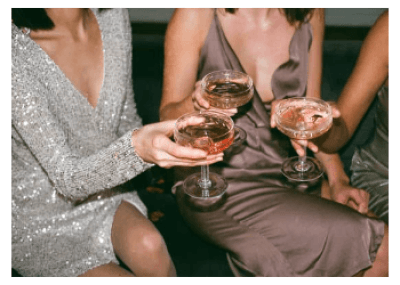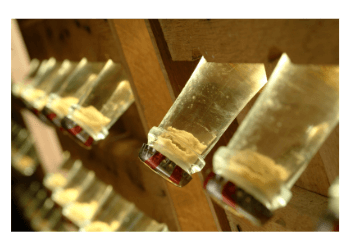No products in the basket.
Vintage champagne is often talked about in much revered terms and the prices it can sell for suggest a far superior product to non-vintage champagne but is vintage champagne so much better than non-vintage? This blogpost looks into what exactly vintage champagne is, how vintage champagne differs from non-vintage champagne and what vintage champagne tends to taste like in comparison to non-vintage. In addition we look into the best vintage champagne years, how long vintage champagne can keep, how best to appreciate vintage champagne and whether it is worth the premium.
First let’s look at non-vintage and vintage champagnes and the differences between the two.
Non-vintage champagne is produced year on year in a consistent house style and, to achieve that consistent style, champagne houses have to use a blend of wines produced from grapes from different vineyards picked in different years, often many different years, and usually, though not always from all three of the authorised champagne grapes – Chardonnay, Pinot Noir and Pinot Meunier. Reserve wine is kept back each year to use in the non-vintage blend (or cuvée) and accounts for about 20% of the total blend.
It is a real skill producing that consistency of style that non-vintage champagne tends to have given the differences each year in grape quality and weather and taking into account the effects of ageing on the reserve wines. So, if you find a non-vintage champagne that you really like, I always recommend that you stick to that brand because you can be pretty sure that the taste and quality will stay the same. In my case de Castellane non-vintage Brut Champagne (above) has been my favourite for many years and remains so which is why it was the first wine that I wanted in the Wines With Attitude portfolio.
Vintage champagne is not produced every year but only when the producer deems the vintage to be worthy – it is usually about three or four times each decade. Some champagne houses only produce vintage champagne, Dom Perignon for example, which means that they don’t produce champagne every year, adding to the rarity value – and to the price.

All the grapes used to produce a vintage champagne must be from the year’s harvest specified on the front label of the bottle. No reserve wines from other years can be added. They are generally still blends however as the winemaker mixes the juice from different grapes and from grapes from different plots with different terroirs but instead of looking for a consistent style, they are trying to achieve the best tasting champagne from the best grapes grown in the specific conditions of that vintage.
Each vintage champagne will therefore taste different; even a specific champagne house’s vintage champagne will taste different each year it is produced.
There are some who think that, even in vintage years, the priority for most champagne houses has to be the non-vintage champagne as that is what they sell most of; it has to be hoped that using the better grapes for the vintage champagne does not compromise the known style of the non-vintage champagne but there are some who believe that it does.
Non-vintage champagnes must mature in bottle for a minimum of 15 months of which 12 months must be on the lees (mainly a deposit of yeasts which forms after the second fermentation in the bottle has finished, as seen in the photo). Vintage champagne spends longer ageing, at least three years. In practice it is often much longer before any wines are released – two to three years for non-vintage and four to ten years for vintage. The additional ageing time means that vintage champagne develops more body, more complex flavours and a smoother texture.
In younger non-vintage champagne the primary flavours will be fruit – citrus fruits like lemon and grapefruit and stone fruits like peach and apricot. In non-vintage champagne that has aged a while a buttery or creamy texture and secondary flavours like brioche/ toast and nuts may start to develop. These secondary flavours will be more intense in vintage champagne because of the longer ageing; in addition the body will be fuller, the wine richer and further earthy flavours and aromas like leather and mushrooms may be present.

Vintage champagne is likely to age better and for longer. Non-vintage champagne should generally be drunk within 36-48 months of bottling (remember it has already aged at least 12 months in bottle before release) whereas non-vintage champagne can be kept for five to ten years or longer (after its minimum three years ageing in bottle).
Of course it is all a matter of taste but generally the following years are considered to be the very best vintages of the 2000s – 2018, 2012, 2008 and 2002.
I would recommend serving vintage a little less chilled than non-vintage champagne say at 12-14°C so that the complex flavours of the wine are not masked. Also allow the champagne to breathe for 15-30 minutes so that the layers of unique aromas and flavours have time to unfold. Sit back and enjoy!
Vintage champagne is generally currently priced at around £40-£60 but can be hundreds of pounds per bottle; the fact that vintage champagne represents only 5% of total champagne production and the longer ageing time account to some extent for the difference in price. But at the end of the day, you are taking a bit of a chance; although the winemaker is trying to impress with a wine made from the best fruits from the best years, it really is all a matter of taste. Whether you think a wine is worth the premium, depends on the particular vintage and the particular wine and your own preferences.
I recall one blind tasting of sparkling wines that I hosted where a vintage champagne from a well-known champagne house was the least favourite wine of the evening – and was believed to be a cheap, tank method-produced, new world, sparkling wine. It was certainly an acquired taste – very yeasty with lots of earthy flavours and with small bubbles which did not last long. Guests could not believe that it cost (then) £45. On the other hand at a recent tasting a £28 vintage champagne, cheaper than some non-vintage champagnes, went down very well with all those tasting it.
Perhaps we have become a little too nonchalant about non-vintage champagne given its prevalence on the supermarket shelves, often priced at a discount. The UK, by the way, accounts for 23% of all champagne exports and is by far the largest importer. If you prefer those primary fruity flavours with a tough of bready notes, find a brand of non-vintage that you like but if you like a richer style and nuttier flavours consider trying vintage champagne; any reputable wine merchant should be able to give you advice on where to start.
© 2014-2025 Wines with Attitude Ltd | VAT Reg. No. 181 2419 22 | Registered in England 08918466 | Fiveways, 57-59 Hatfield Road, Potters Bar, Herts, EN6 1HS